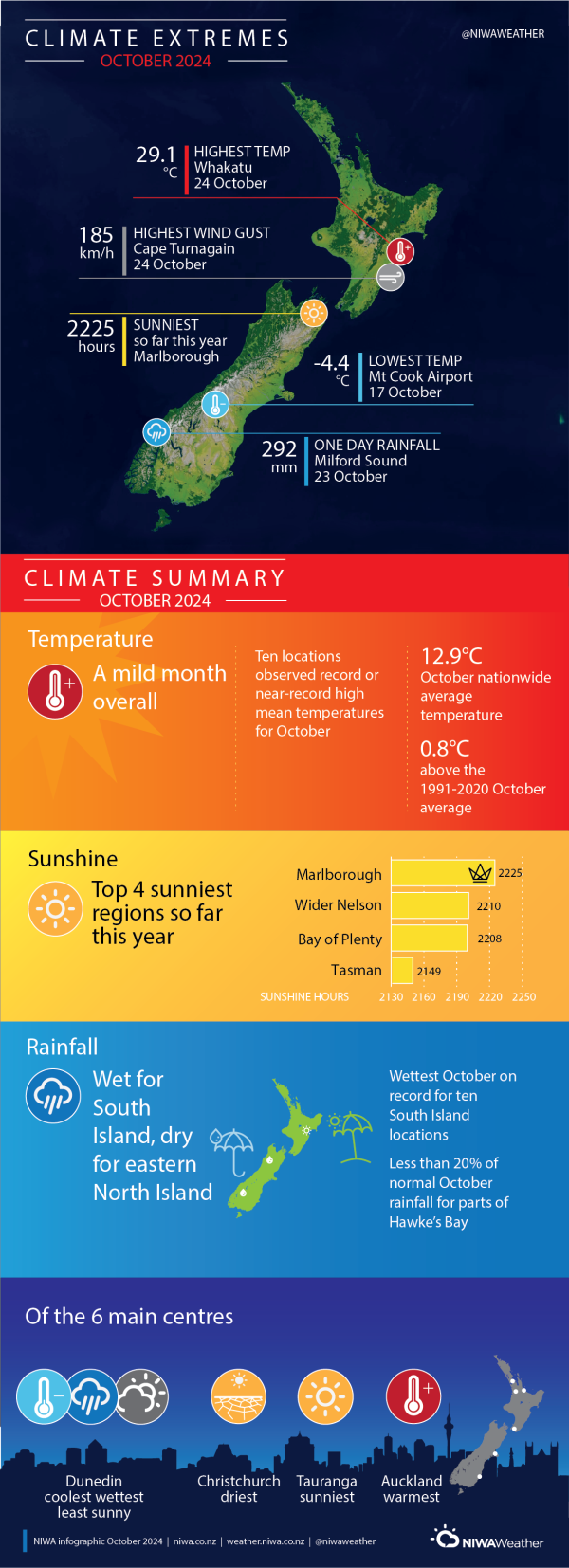Overview
| Temperature | Temperatures were above average (0.51°C to 1.20°C above average) or well above average (>1.20°C above average) for most of the North Island, Marlborough, northern and eastern Canterbury, West Coast, Fiordland, and eastern parts of Otago. Near average temperatures (±0.50°C of average) occurred in northeastern Northland, Tasman, Nelson, inland parts of southern and central Canterbury, inland Otago, and central and southern Southland. |
| Rainfall | Rainfall was above normal (120-149% of normal) or well above normal (>149% of normal) in much of the South Island, southern Wellington, Bay of Plenty, southern and central parts of Waikato, and northwestern parts of Northland. Below normal (50-79% of normal) or well below normal (<50% of normal) rainfall was observed in Gisborne, Hawke’s Bay, southern parts of the Central Plateau, northeastern parts of Wairarapa, and Banks Peninsula. |
| Soil Moisture | At the end of the month, soil moisture levels were higher than normal across northern Southland, Otago, much of Canterbury, Marlborough, Nelson, southwestern parts of the North Island, and western parts of Northland. Below normal soil moisture was observed in Gisborne and Hawke’s Bay. Elsewhere, soil moisture levels were generally near normal. |
October 2024 was characterised by higher than normal mean sea level pressure to the south and east of Aotearoa New Zealand. This produced more easterly airflows than normal over the lower South Island, and more northerly airflows than normal over the North Island. Temperatures were above average (0.51°C to 1.20°C above average) or well above average (>1.20°C above average) for most of the North Island, Marlborough, northern and eastern Canterbury, West Coast, Fiordland, eastern parts of Otago, and eastern Southland. Near average temperatures (-0.50°C to +0.50°C of average) occurred in northern and eastern parts of Northland, Coromandel Peninsula, coastal parts of southern Gisborne, Tasman, Nelson, inland parts of southern and central Canterbury, inland Otago, and central and southern parts of Southland. The nationwide average temperature in October 2024 was 12.9°C. This was 0.8°C above the 1991-2020 October average, making it New Zealand’s 16th-warmest October since NIWA’s seven station temperature series began in 1909.
Rainfall was above normal (120-149% of normal) or well above normal (>149% of normal) in much of the South Island, southern Wellington, Bay of Plenty, southern and central parts of Waikato, and northwestern parts of Northland. It was particularly wet in Dunedin and Oamaru, where more than four times normal October rainfall was recorded. In contrast, it was a dry month for Gisborne, Hawke’s Bay, southern parts of the Central Plateau, northeastern parts of Wairarapa, and Banks Peninsula, where rainfall was below normal (50-79% of normal) or well below normal (<50% of normal). Near normal rainfall (80-119% of normal) was observed elsewhere.
Further Highlights:
- The highest October temperature was 29.1°C, observed at Whakatu on 24 October.
- The lowest October temperature was -4.4°C, observed at Mount Cook Airport on 17 October.
- The highest 1-day rainfall was 292 mm, recorded at Milford Sound on 23 October.
- The highest wind gust was 185 km/h, observed at Cape Turnagain on 24 October.
- Of the six main centres in October 2024, Auckland was the warmest, Christchurch was the driest, Tauranga was the sunniest, and Dunedin was coolest, wettest, and least sunny.
- Of the available, regularly reporting sunshine observation sites, the sunniest four regions in 2024 so far are Marlborough (2225 hours), wider Nelson (2210 hours), Bay of Plenty (2208 hours), and Tasman (2149 hours).


